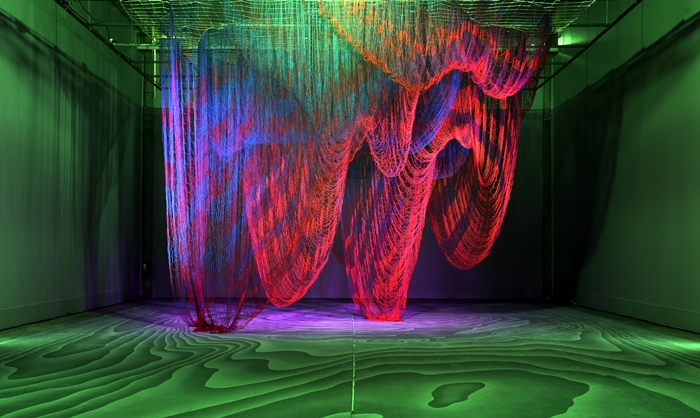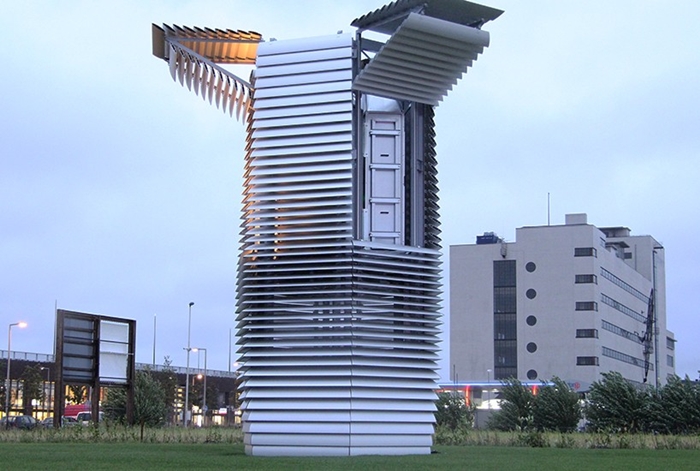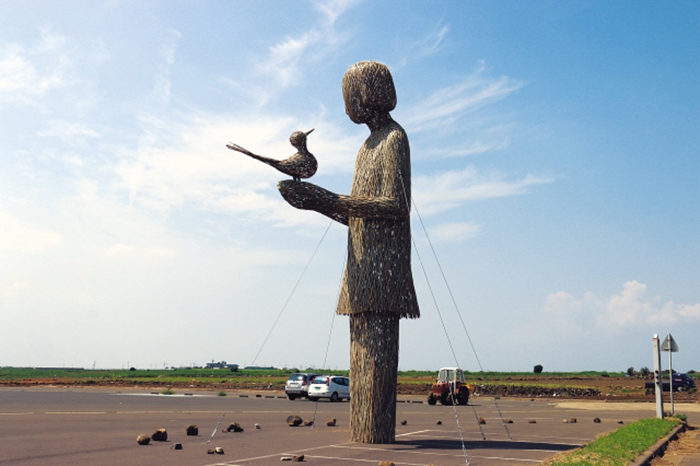
At the 2017 Cheongju Craft Biennale, visitors can take a look at U.S. sculptor Janet Echelman's 'Line Traveling Through Space and Time,' an installation piece that can be viewed while laying on a carpet. (Cheongju Craft Biennale)
By Kang Gahui and Lee Hana
In Korea, autumn is the season of art biennales. Worthy of note this season are three large-scale international art exhibitions that kicked off this September in Cheongju, Gwangju and on Jeju Island.
The 2017 Cheongju Craft Biennale, in its 10th year, will run from Sept. 13 to Oct. 22 at the old tobacco processing plant in Cheongju City, Chungcheongbuk-do Province. This international craft biennale is known for its wide selection of pottery, woodcraft, textiles and metal crafts.
The highlight of this year's show is the Global Pavilion, under the themes "The Future of Craft" and "Craft in Daily Life." This section features 497 pieces by 232 artists from nine different countries, including Korea, the U.K., Germany, Switzerland and Japan.
Major works displayed at the festival include an aerial fishing net titled "Line Traveling Through Space and Time" by U.S. sculptor Janet Echelman, and a 3-meter paper work of art by Chinese artist Wu Jian'an, made using a traditional Chinese paper-cutting technique.
Visitors can also buy goods at a crafts fair, an art fair and a street market on the third floor of the venue. The entrance fee is KRW 10,000 for adults, KRW 5,000 for students and KRW 4,000 for children.

The 2017 Gwangju Design Biennale features many futuristic works of art, like 'Smog Free Tower Project' by Dutch artist Daan Roosegaarde, on display in the Design the Future exhibition space. The piece is a giant air purifier meant to provide clean air in public spaces, free of charge. (Gwangju Design Biennale)
The seventh Gwangju Design Biennale will run this year from Sept. 8 to Oct. 23 at the Gwangju Biennale Exhibition Hall, the Gwangju Museum of Art, and at the Asia Cultural Center, all in Gwangju City, Jeollanam-do Province. This biennale focuses on the latest trends in design, exploring the impact of design on modern society.
The theme of this year's festival is "Futures," and will touch on topics that explore the paradigm of the fourth industrial revolution. Some 485 designers and 367 companies from 34 countries, including the U.K., Italy, the U.S. and China, will showcase their work. The biennale is divided into four main exhibition halls with two special exhibitions, an international academic forum and other events.
The main exhibition, "Futures of the Past," features works like 'Smog Free Tower Project' by Dutch artist Daan Roosegaarde, a giant functional air purifier meant to provide cleaner air in public spaces, free of charge. There is also the "Jellyfish Barge," a floating agricultural greenhouse, able to purify salt, and brackish or polluted water using only solar energy.
The entrance fee is KRW 12,000 for adults, KRW 6,000 for students and KRW 4,000 for children.

The Alddreu Airfield, an outdoor exhibition space for the Jeju Biennale, was once used as a Japanese military outpost in the 1930s and during the Second Sino-Japanese War (1937-1945). A sculpture titled 'Bluebird' by artist Choi Pyunggon has been installed in the middle of the airfield for the biennale. (Jeju Biennale)
The Jeju Biennale, founded this year, is organized by Jeju City and will run for three months, from Sept. 2 to Dec. 3. The biennale aims to be a social art project that explores Jejudo Island through the theme of tourism.
Some 70 teams from over 15 countries will be showcasing their artworks at various locations across the island, such as at the Jeju Museum of Art, the Jeju Museum of Contemporary Art, the Alddreu Airfield and other venues in downtown Jeju City.
The exhibitions examine Jejudo Island's tourism industry from a historical and societal angle, exploring its history, destruction of the natural environment, and the conflicts and changes that face Jeju residents. The Alddreu Airfield, one of the biennale's outdoor exhibition spaces, was once used as a Japanese military outpost in the 1930s when the Second Sino-Japanese War broke out in 1937. Here, visitors can see "Bluebird," a 9-meter statue of a young woman holding a bird that symbolizes peace. Another installation piece here, "Between the Boundary" by Jeon Jong Cheol, forces the viewer to observe the historical site from inside a hangar, blocked with wire mesh.
Other works include the "Halla Salon," which pieces together a total of 60 artworks inspired by Hallasan Mountain, and "DMZ Project," a close observation by 10 teams of the demilitarized zone and the areas along that border. The entrance fee is KRW 6,500 for adults, KRW 4,000 for students and KRW 2,000 for children.
kgh89@korea.kr